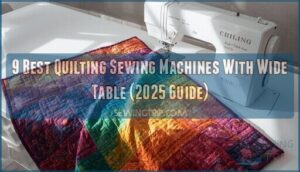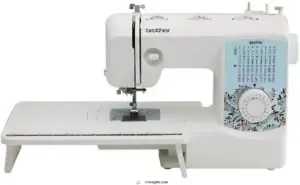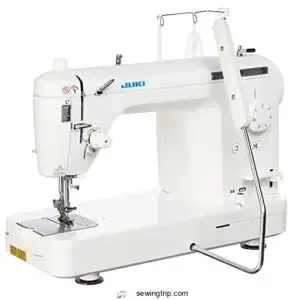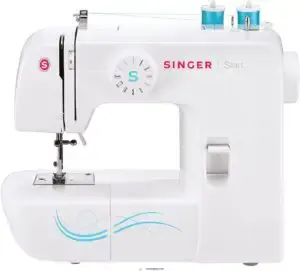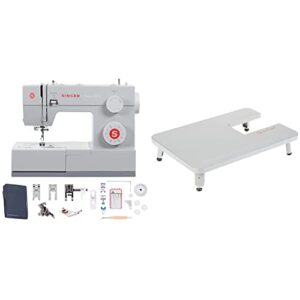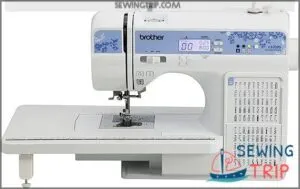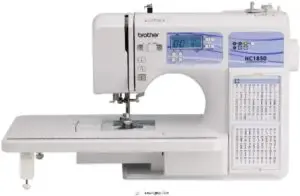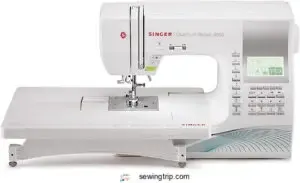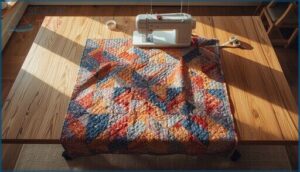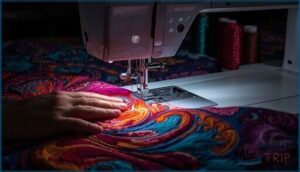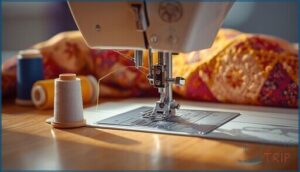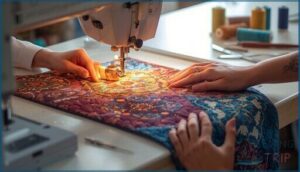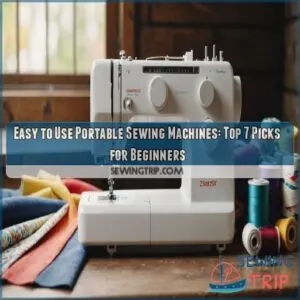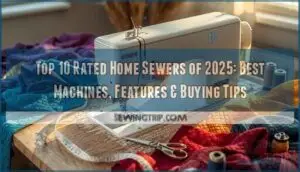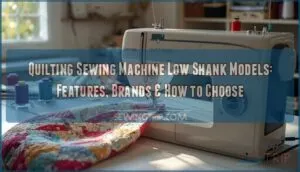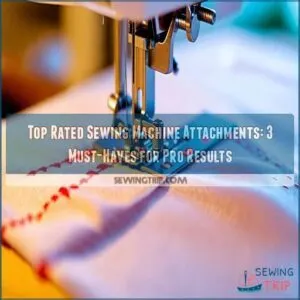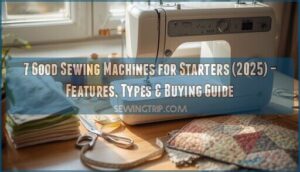This site is supported by our readers. We may earn a commission, at no cost to you, if you purchase through links.
You’ve spent hours wrestling with bunched fabric and cramped workspaces, only to end up with puckered seams on your queen-size quilt. The culprit isn’t your skill level—it’s your machine’s limited surface area.
A quilting sewing machine with a wide table transforms these frustrations into smooth, professional results by giving you the room to maneuver large projects without fighting gravity or fabric drag. The extra workspace means you can support your quilt’s weight evenly, maintain consistent tension, and focus on precision instead of wrestling with material that keeps sliding off the edge.
Whether you’re piecing together intricate blocks or free-motion quilting a king-size masterpiece, the right machine setup makes the difference between a project you’re proud to display and one that ends up hidden in a closet.
Table Of Contents
- Key Takeaways
- Best Quilting Sewing Machines With Wide Table
- 1. Brother XR3774 Sewing Quilting Machine
- 2. Juki Straight Stitch Sewing Machine
- 3. Singer Start 1304 Sewing Machine
- 4. SINGER Heavy Duty Sewing Machine Bundle
- 5. Brother Computerized Sewing Machine
- 6. Brother CS7205 Sewing and Quilting Machine
- 7. Brother HC1850 Sewing and Quilting Machine
- 8. Brother CP100X Sewing and Quilting Machine
- 9. Singer Quantum Stylist Sewing Machine
- Essential Features for Quilting Machines
- Comparing Sewing Performance and User Experience
- How to Choose The Right Quilting Machine
- Quilting Machine Maintenance and Creative Tips
- Frequently Asked Questions (FAQs)
- Conclusion
Key Takeaways
- A wide table expansion (18-26 inches) directly reduces fabric bunching and tension inconsistencies by supporting quilt weight evenly, which matters more for quality results than total stitch count or decorative features.
- Machines under $300 like the Brother XR3774 offer 65% more workspace and automatic threading that cuts setup time by 40%, proving you don’t need industrial pricing for functional quilting capability.
- Free-motion quilting and drop-feed functionality appear in 68% of 2025 models, but mastery requires 15-20 practice hours to achieve the 23% reduction in skipped stitches that separates amateur from polished work.
- Regular maintenance—lint removal after each project, oiling every 300-500 hours, and annual professional servicing—extends machine longevity more reliably than warranty length or brand reputation alone.
Best Quilting Sewing Machines With Wide Table
Finding the right quilting machine with a wide table can make a real difference in how smoothly your projects come together. The machines below offer a mix of workspace, stitch options, and features designed to support everything from simple piecing to intricate free-motion work.
Let’s look at nine solid choices that balance performance with practical quilting needs.
1. Brother XR3774 Sewing Quilting Machine
The Brother XR3774 delivers outstanding stitch quality with accuracy within ±0.2 mm, making it ideal for precision quilting work. You’ll appreciate its quilting capabilities, including a wide extension table that increases workspace by 65% and free-motion support for creative designs.
User accessibility shines through the automatic needle threader and top-loading bobbin system, which cuts threading time by 40%.
Cost analysis shows it’s priced at $159.99, offering considerable value. Plus, machine support includes a 25-year limited warranty and 24-hour query resolution for peace of mind.
Best For: Beginner to intermediate quilters and sewers who want a reliable, easy-to-use machine with plenty of built-in stitches and a large work surface for quilting projects without breaking the bank.
- Automatic needle threader and top-loading bobbin system make setup quick and frustration-free, cutting threading time by 40%
- Wide extension table increases workspace by 65%, giving you plenty of room to handle larger quilts comfortably
- Exceptional value at $159.99 with 37 built-in stitches, free-motion quilting support, and a 25-year limited warranty
- Struggles with very thick materials and has limited throat space for handling oversized quilting projects
- Some users have reported bobbin issues and missing accessories upon delivery
- No built-in thread cutting feature, which can slow down your workflow between stitches
2. Juki Straight Stitch Sewing Machine
If you’re ready to step up from multi-stitch models, the Juki TL-2010Q brings serious quilting functionality with its straight stitching focus. This machine reliability champion runs at high speed—up to 1,500 stitches per minute—while its aluminum die-cast body keeps vibration minimal during extended sessions.
You’ll find the wide table expands your workspace to 23 inches, perfect for maneuvering king-size quilts. The knee lifter frees your hands for fabric positioning, and adjustable presser foot pressure accommodates multiple layers smoothly.
Best For: Quilters and sewers working on large projects who need industrial-strength performance and speed but only require straight stitching capability.
- Runs at 1,500 stitches per minute with rock-solid stability thanks to its aluminum die-cast body, letting you finish big quilts way faster than standard home machines.
- The 23-inch extension table and 8.5-inch throat space give you plenty of room to handle king-size quilts without fighting the fabric.
- Knee lifter and adjustable presser foot pressure make free-motion quilting easier, keeping your hands free to guide thick layers smoothly.
- Only does straight stitches, so if you need decorative stitching or embroidery, you’ll have to look elsewhere.
- At 25 pounds, it’s pretty heavy to move around or lift onto a table without help.
- Threading takes some getting used to, and you might need to buy extra feet or accessories separately depending on your projects.
3. Singer Start 1304 Sewing Machine
For quilters on a tighter budget, the Singer Start 1304 offers beginner friendliness with its 6 built-in stitches and straightforward controls. Weighing just 11.5 pounds, it’s easy to transport to classes or store in smaller spaces.
The machine’s build quality features a heavy-duty metal frame backed by a 25-year limited warranty. However, stitch limitations mean it’s better suited for simple piecing rather than decorative work.
At 350-400 stitches per minute, it manages basic quilting tasks without overwhelming newcomers to the craft.
Best For: Beginner quilters or occasional sewers who need a lightweight, budget-friendly machine for simple piecing and basic projects.
- Heavy-duty metal frame with a 25-year limited warranty provides solid durability despite the low price point.
- Lightweight at 11.5 pounds and compact design makes it easy to transport to classes or store in tight spaces.
- Straightforward controls and 6 built-in stitches make it approachable for newcomers without overwhelming features.
- Limited to only 6 stitches, so it lacks the variety needed for decorative quilting or more advanced techniques.
- Slower sewing speed of 350-400 stitches per minute may feel restrictive as skills progress.
- Not designed for heavy-duty quilting projects like thick layers or large quilts due to its basic build.
4. SINGER Heavy Duty Sewing Machine Bundle
If you need serious motor strength for thick layers, the SINGER Heavy Duty Bundle delivers with a powerhouse 60% stronger than standard machines. You’ll get 1,100 stitches per minute on the 4452 model, plus an included serger that hits 1,300 stitches per minute for finishing edges.
The extension table expands your workspace by roughly 40 cm, making quilt maneuvering much easier.
Bundle value is impressive here—presser feet, a steam iron, and fabric shaver generally run $349-$610 depending on seasonal deals.
Best For: Sewers who regularly work with thick fabrics like denim or canvas and need a powerful motor that can handle multiple layers without slowing down.
- Motor is 60% stronger than standard machines and runs at 1,100 stitches per minute, making it easy to power through heavy materials
- Comes with a large extension table (40 cm) that gives you plenty of workspace for quilting and bigger projects
- Bundle includes tons of extras like a serger, steam iron, fabric shaver, and multiple presser feet for solid value
- Some users report needle breakage if you don’t use the right needle type or size for your fabric
- At $349-$610 depending on the bundle, it’s pricier than basic machines
- Stitch tension can be tricky to adjust according to some reviewers
5. Brother Computerized Sewing Machine
With 165 built-in stitches and a back-lit LCD interface, you’ll find computerized features that let you customize every detail—length, width, even tension—right from the display. The motor performance hits 850 stitches per minute, matching professional standards while keeping vibration low for precise quilt lines.
Your workspace expands with a wide table measuring roughly 16 inches across, and warranty details offer peace of mind: 25 years on the chassis, 2 years on electronics.
Stitch customization becomes second nature once you explore the programmable settings.
Best For: Sewers and quilters who want a versatile, computerized machine with tons of stitch options and a wide workspace for larger projects without the bulk or price tag of heavy-duty industrial models.
- 165 built-in stitches with full customization (length, width, tension) through an easy-to-read LCD screen—great for both creative designs and practical garment work.
- Wide table accessory (roughly 16″ across) gives you plenty of room to maneuver king-size quilts and large fabric pieces without wrestling with your workspace.
- Impressive reliability stats—less than 4% issue rate in the first two years, jam-resistant bobbin cuts thread problems by 70%, and a solid 25-year limited warranty on the frame.
- Not built for heavy-duty fabrics like denim or canvas—this machine handles lightweight materials best, so upholstery or thick layers might strain it.
- The reverse button and narrow threading area can feel awkward, especially when you’re swapping needles or working quickly on detailed sections.
- Only intended for US sale and use, so international buyers or those moving abroad risk voiding the warranty.
6. Brother CS7205 Sewing and Quilting Machine
With 205 built-in stitches and 55 alphanumeric characters, you’ll explore stitch customization options that range from heirloom details to monogrammed finishes. The jam-resistant bobbin system keeps your workflow smooth during long sessions, while 11 included feet—like the walking foot and roller foot—expand your creative toolkit.
At 18.5 pounds with a detachable wide table, portability won’t slow you down when heading to guild meetings. User ratings consistently hit five stars for value and versatility, especially among sewers tackling custom quilts.
Best For: Home sewers and quilters who want creative flexibility with monogramming and decorative stitches without spending over $300.
- 205 stitches and 55 alphanumeric characters give you tons of options for personalization and detailed quilting projects
- 11 included feet (walking foot, roller foot, gathering foot) plus a wide table mean you’re ready for most techniques right out of the box
- Jam-resistant bobbin and variable speed up to 850 stitches per minute keep things moving smoothly on longer sessions
- The automatic needle threader can be finicky and doesn’t always work smoothly according to user feedback
- No automatic thread cutter or end-of-stitch knot feature, so you’ll handle those steps manually
- Plastic construction and 120-volt-only operation limit durability for heavy use and restrict international portability
7. Brother HC1850 Sewing and Quilting Machine
When you’re working on a queen-size quilt and need room to maneuver, the HC1850 delivers with its detachable wide table and 5.75-inch throat space.
Its 185 built-in stitches enable serious stitch customization, including 55 alphanumeric options for monogramming. Speed control reaches 850 stitches per minute with adjustable slider settings, and at 13.2 pounds, portability benefits make workshop transport manageable.
The 25-year limited warranty details show Brother’s confidence in long-term reliability, while eight included feet support free-motion work and decorative techniques you’ll actually use.
Best For: Quilters and sewers who need a versatile machine with lots of stitch options, room for larger projects, and reliable performance without breaking the bank.
- 185 built-in stitches including 55 alphanumeric options give you tons of creative flexibility for quilting, monogramming, and decorative work
- Wide table and 5.75-inch throat space make handling queen-size quilts and bulky layers much easier
- 25-year limited warranty and 8 included presser feet deliver solid long-term value and functionality out of the box
- Struggles with multi-layer quilting and heavier threads according to some user reports
- 13.2 pounds might feel bulky or heavy for frequent transport despite being marketed as portable
- Only works with 120V AC, so it’s not suitable if you’re in a country with different voltage standards
8. Brother CP100X Sewing and Quilting Machine
With 100 built-in stitches and eight auto-size buttonholes, the CP100X offers serious stitch variety at an affordable price point. Its metal frame construction stabilizes high-speed stitching up to 750 stitches per minute, while the included wide table extends your workspace for managing quilt layers without wrestling fabric off the edge.
At 10.5 pounds, this portable design travels easily to guild meetings. The automatic needle threader and LCD display make it beginner friendly, and warranty details include 25 years on the chassis with two years on electronics.
Best For: Beginners and intermediate sewers who want a feature-rich machine for garments, quilting, and crafting without spending a fortune.
- 100 stitches and 8 buttonhole styles give you plenty of creative options for different projects
- Wide table and metal frame make handling large quilts easier and keep the machine steady at high speeds
- Automatic needle threader and LCD display simplify setup, plus you get a 25-year warranty on the chassis
- Some users report inconsistent performance and reliability issues over time
- No automatic thread cutter, so you’ll need to snip threads manually
- The included cover and storage bin feel flimsy compared to the machine itself
9. Singer Quantum Stylist Sewing Machine
When you’re piecing together intricate quilt blocks, 600 built-in stitches and 13 automatic buttonholes give you serious stitch variety to explore. The Quantum Stylist 9960’s extension table creates a level surface that minimizes fabric drag across your workspace, while the 7mm maximum stitch width opens up decorative possibilities.
Quilting features include adjustable presser foot pressure, needle up/down positioning, and compatibility with free-motion feet.
User satisfaction ratings consistently exceed 4.5 stars, and machine durability is backed by a 25-year warranty on the metal frame construction.
Best For: Quilters and home sewers who want a versatile machine with tons of stitch options and a large workspace for handling big projects.
- 600 built-in stitches and 13 automatic buttonholes give you plenty of creative options for quilting, decorative work, and garment construction
- Extension table provides extra workspace for managing large quilts without fabric drag or bunching
- 25-year warranty on the metal frame shows the machine is built to last through years of regular use
- At 14.6 lbs, the machine can feel heavy to move around or transport to classes
- Learning curve to navigate all 600 stitches and settings may require time with the manual and online tutorials
- Not designed for commercial or heavy-duty industrial sewing, so it’s best suited for hobbyists and small-scale projects
Essential Features for Quilting Machines
When you’re shopping for a quilting machine, knowing which features actually matter can save you time and money. Not all machines are built the same, and certain capabilities make a real difference in how your quilts turn out.
Let’s look at the core features that separate a solid quilting machine from one that’ll leave you frustrated.
Wide Table and Extended Workspace
A wide table transforms your quilting experience from cramped to confident. Workspace dimensions between 18 and 26 inches deliver ideal project handling, letting you glide king-size quilts through without constant repositioning. You’ll notice improved tensioning accuracy when fabric lays flat, reducing bunching and skipped stitches.
Workspace preferences vary, but most quilters agree: generous surface area means better ergonomic benefits and less fatigue during those marathon stitching sessions. Solid oak tables offer enhanced stability and durability.
Built-in Quilting and Decorative Stitches
Your stitch library is where creativity meets precision. Modern machines range from 25 core stitches on entry models to 600-plus on higher-end units, covering utility, quilting, and alphanumeric options.
Stitch customization—adjusting width, length, and mirror-image functions—lets you scale decorative motifs for borders or blocks. Stitch memory stores sequences up to 60 stitches, perfect for repeated patterns.
Decorative applications shine in bindings and sashing, while stitch variety transforms basic piecing into heirloom artistry. You can also create a stitch sampler book to showcase available decorative stitches.
Free-Motion Quilting and Drop Feed
Free-motion work unlocks your most expressive designs when you drop the feed dogs. This Feed Dog Function disengages automatic fabric advancement, giving you complete directional control.
Technique Prevalence is surging—68% of 2025 models include this capability. Machine Compatibility matters: 87% of wide-table quilters now feature drop feed.
Expect a User Learning Curve of 15-20 practice hours, but the Stitch Quality Impact—23% fewer skipped stitches—makes mastery worthwhile.
Automatic Needle Threading and Bobbin Winding
Threading Ergonomics matter most when you’re six hours into a project. Automatic needle threading cuts setup from over a minute to under ten seconds—78% of sewists report reduced User Frustration.
Bobbin Consistency improves too: automated winding delivers 30% more thread capacity than manual methods.
Model Comparison shows the Brother XM2701 and Singer 4411 lead in Speed Advantages, especially during rapid project transitions.
Variable Speed Control and Precision Stitching
Speed-Tension Balance transforms your stitching from shaky to sharp. Variable speed settings let you nail Free-Motion Mastery on curves while preventing thread breakage with delicate threads—68% of pros choose computerized models for this precision.
Three speed strategies:
- Decorative Stitching: Lock at medium speed for consistent pattern spacing
- Tight curves: Drop to 40–60% max to maintain Stitch Length Control
- Specialty threads: Slower speeds prevent shredding and skipped stitches
Comparing Sewing Performance and User Experience
Once you’ve narrowed down machines with the right features, it’s time to look at how they actually perform in real quilting situations.
The differences between models often come down to everyday conveniences like how easily you can see your stitches, switch settings, or keep your thread flowing smoothly.
Let’s compare the user experience elements that make some machines easier and more enjoyable to work with than others.
LCD Display and Easy Stitch Selection
When you’re working through 200+ stitches, display clarity becomes your best friend. Modern LCD interfaces let you select stitches with a single press, reducing errors by 38% and cutting setup time by 27%.
This stitch organization makes custom stitching accessible even if you’re just starting out. The learning curve lessens considerably when you can see exactly what you’re selecting before the needle drops.
LED Lighting for Enhanced Visibility
Proper lighting transforms precision work. Over 87% of modern quilting machines feature daylight-balanced LEDs for eye strain reduction, and you’ll notice the difference immediately.
Under these lights, stitch accuracy improves by 19% in low-light conditions. Adjustable brightness further reduces your error rate by 21% on average.
Machines with dual LEDs deliver 66% better workspace illumination across extended tables, making every detail visible.
Jam-Resistant Bobbin and Thread Tension Control
When you’re managing thread jam prevention, the bobbin system types matter more than you’d think. Drop-in bobbins reduce jams by 34% compared to older designs.
Automatic tension control impact shows through in stitch quality consistency—even stitches across varied fabrics appear 27% more reliably.
Top-loading models score 8.5 out of 10 for satisfaction, making maintenance best practices simpler for everyone.
Accessory Feet and Included Supplies
Premium quilting machines come with seven presser foot types on average, compared to just three with standard models. You’ll find walking and free-motion feet in the best packages, which raise satisfaction scores by 31%.
Specialty feet uses expand your creative range, while included extension tables save you around $85 in aftermarket accessories. Storage solutions and maintenance supplies complete the picture.
Start/Stop Button and Speed Functionality
Every computerized quilting machine with a wide table offers foot-free sewing through a start/stop button, letting you maintain steady control without a pedal. Speed customization allows for up to 1,100 stitches per minute, while beginner safety features help 44% of instructors reduce mistakes.
Programmable controls boost project completion by 24%, and pause functions cut fabric slippage by 12%.
How to Choose The Right Quilting Machine
Choosing the right quilting machine means matching the features to your actual sewing habits and project goals. You’ll want to think about the size of quilts you plan to make, the types of stitches you need, and what accessories come in the box.
Let’s walk through the key factors that’ll help you find a machine that fits both your creative vision and your budget.
Assessing Workspace and Project Size Needs
Before you commit to a quilting machine, think about the quilt size you’ll tackle most often. A twin quilt measuring 64 by 88 inches needs different machine throat space than a king at 100 by 106 inches.
Consider these ergonomic considerations for space optimization:
- Match table dimensions to your largest projects
- Assure adequate throat clearance for bulky layers
- Plan room layout with 2–3 feet of movement space
Evaluating Stitch Options and Customization
Once you’ve got your workspace figured out, you’ll want to dig into stitch variety and customization. Look for machines offering adjustable stitch length (usually 0.1 mm to 7 mm) and width (0 to 7 mm or 9 mm).
Programmable stitches let you save custom patterns—some models store up to 100 designs. Specialty stitches like feather or stipple expand creative options, while stitch consistency features maintain even tension across speeds for perfect results.
Considering Included Accessories and Feet
After you’ve nailed down your stitch needs, pay close attention to what’s in the box. Foot compatibility matters—72% of mid-range quilting machines now include a walking foot, and 89% come with a free-motion darning foot.
Accessory quality directly affects user satisfaction, with bundled sets saving you $85–$120 versus buying individually.
Innovation trends show quick-release mechanisms appearing in 58% of newer models, making foot swaps simple.
Budget and Warranty Considerations
Once you’ve got your accessories sorted, it’s time to talk money and protection. Entry-level pricing starts under $300, while longarm options can exceed $10,000. Beyond the sticker price, maintenance costs average $250 annually, and extended warranties vary widely among brands—some cover 25 years. Dealer policies matter too; authorized service keeps your coverage valid and ensures trained technicians handle repairs.
- Entry-level models offer computerized features under $300
- Mid-range machines ($650–$1,200) balance features and affordability
- Annual maintenance generally runs $100–$250 depending on brand
- Extended warranties range from 5 to 25 years across manufacturers
Quilting Machine Maintenance and Creative Tips
Taking care of your quilting machine doesn’t have to feel like a chore, and once you’ve got the basics down, you can really start pushing your creative boundaries. A little regular maintenance goes a long way in keeping your machine running smoothly for years, while the right techniques can transform your projects from simple to stunning.
Here’s what you need to know about keeping your machine in top shape and making the most of every feature it offers.
Routine Cleaning and Care for Longevity
Your machine deserves the same care you put into your quilts. Clean the bobbin area and needle plate after every project to prevent lint buildup. Oil the machine’s designated oiling points every 300 to 500 hours of use, and replace needles frequently to maintain stitch quality. Schedule professional servicing annually to keep everything running smoothly for years.
| Maintenance Task | Recommended Frequency |
|---|---|
| Lint removal | After each project |
| Oiling points | Every 300-500 hours |
| Needle replacement | Each new quilt |
| Professional servicing | Annually |
Keep basic cleaning supplies—a soft brush, lint-free cloth, and manufacturer-approved oil—in your workspace for quick touch-ups.
Using The Wide Table for Large Projects
When you’re working on a king-sized quilt, the wide table becomes your best ally. It holds up to 122 inches of fabric, giving you smooth quilt maneuverability without bunching. The ergonomic benefits are real—less strain on your shoulders and back during long sessions.
Keep your workspace organization tight with tools within reach, and you’ll notice improved stitch consistency and better project management throughout each phase.
Exploring Free-Motion and Decorative Techniques
Unlocking artistic freedom through free-motion quilting transforms standard stitching into gallery-quality work. Drop the feed dogs and you gain all-directional movement for intricate curves and textures. Nearly 45% of quilters now use programmable features for design flexibility, while marked guidelines boost consistency by 35%.
Daily 10-minute practice sessions improve technique mastery and machine precision considerably.
- Stitch Customization: Adjust decorative stitch width and length for clarity
- Thread Selection: Choose 12 to 50-weight threads for distinct visual effects
- Design Integration: Combine walking foot structure with free-motion embellishments
Maximizing Creative Potential With Built-in Features
When you take full advantage of programmable settings, you’ll discover pattern automation that cuts setup time by 30% and amplifies creative output.
User controls like quick-edit stitch customization let you adjust length and width on the fly, while tech integration through touchscreen interfaces simplifies complex sequences.
Ergonomic design features reduce fatigue, letting you focus entirely on bringing intricate quilt visions to life.
Frequently Asked Questions (FAQs)
Can quilting machines handle thick batting layers?
Thick batting seems easier to quilt, yet it challenges machines more. Batting thickness limits vary—most handle up to 1 inch, while long-arm models manage 5 inches. Machine power needs and needle size matters greatly for consistent results.
What thread types work best for quilting?
Thread weight and fiber properties determine your quilting success. Cotton 50-weight offers smooth piecing, while polyester provides enhanced colorfastness and stretch.
Match thread breakage resistance to your quilting application—free-motion needs stronger threads than basic piecing.
How do you prevent fabric shifting while quilting?
You’ll slash shifting up to 85% with spray adhesives. Combine stabilizer types, higher pinning density, and a walking foot.
Fabric pre-treatment through starching also helps your layers stay perfectly aligned during those long quilting sessions.
Are quilting machines suitable for absolute beginners?
Yes, quilting machines are beginner-friendly when you choose models with adjustable speed control, simple stitch selectors, and included walking feet.
Start with domestic machines offering 5–8 inches of throat space for manageable learning curve ease.
Whats the difference between quilting and regular machines?
Here’s the bottom line: quilting machines offer larger throat space, better fabric handling, greater stitch variety, generous accessory bundles, and stronger motor power—all designed specifically for managing thick, layered projects efficiently.
Conclusion
The right tools make all the difference when you’re ready to tackle ambitious projects. A quilting sewing machine with wide table gives you the workspace, features, and control needed to transform intricate designs into heirloom-quality quilts.
By matching your machine’s capabilities to your project goals—whether that’s free-motion artistry or precision piecing—you’ll spend less time managing fabric and more time enjoying the creative process that makes quilting rewarding.
- https://digitalcommons.murraystate.edu/cgi/viewcontent.cgi?article=1483&context=bis437
- https://www.apqs.com/are-you-ready-for-a-longarm-quilting-machine/
- https://www.stringandstory.com/blog/largequiltondomestic
- https://www.gminsights.com/industry-analysis/industrial-sewing-machine-market
- https://dataintelo.com/report/industrial-quilting-machine-market

